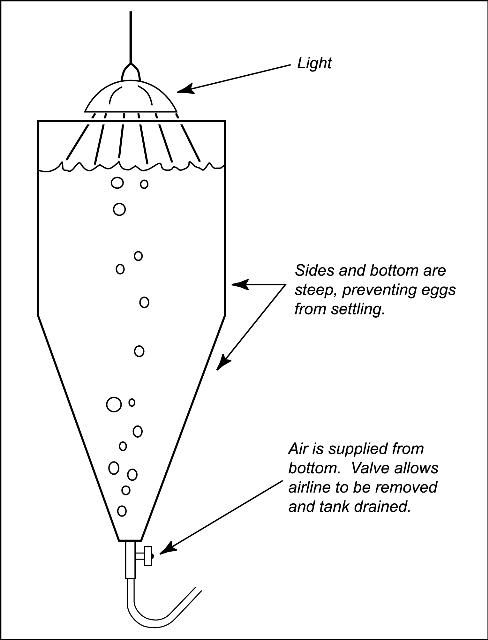Introduction
Brine shrimp eggs are used throughout the world as a food for small fish in hatcheries. These eggs are really cysts which, if they are kept dry, can remain dormant for years before hatching. As soon as the eggs are exposed to water, the hatching process begins. When hatching brine shrimp eggs, we not only produce baby brine shrimp, but also the empty shells out of which they came, along with unhatched eggs. These are mixed in the hatching jar. The unhatched eggs and shells from the hatched eggs must be separated from the baby brine shrimp since they are not digestible if eaten by small fish. If a small fish eats just a few of these shells or unhatched eggs, its intestinal tract may be blocked causing death. The process of separating the shells and unhatched eggs from the baby brine shrimp is quite time consuming and sometimes hard to do effectively.
A process that is used in many hatcheries involves removing the outer layer (shell) of the eggs (decapsulating) with chlorine (household bleach), leaving the unhatched baby brine shrimp protected in a membrane. Besides making the harvest of the hatched brine shrimp easier, this process also:
-
Essentially sterilizes the eggs which may have disease organisms on the outer layer of the egg.
-
Can produce a higher percentage of hatching, since the brine shrimp no longer have to break through the hard outer layer of the egg.
-
Allows you to feed even the unhatched eggs to fish, since the undigestible outer layer of the egg is no longer present.
Decapsulated eggs can be hatched immediately after treating them with chlorine, or can be stored in a saturated brine solution in the refrigerator for up to two months before hatching. This allows you to decapsulate large quantities of eggs, store them, and use small portions as needed. The brine solution dehydrates the eggs, effectively stopping the hatching process. The eggs will hatch normally when placed in a hatching solution of lower salinity water.
Procedure
Note: The following is the procedure for decapsulating one pound of eggs. The amounts of water and household bleach (chlorine) can be changed accordingly if you are working with more or less eggs.
You will need the following items:
-
A 3-gallon container with clear sides
-
1 pound of brine shrimp eggs
-
1 gallon of non-fragranced household bleach (5% chlorine)
-
Brine shrimp net or filter
-
Saturated brine solution*
* In 1 gallon of water, dissolve salt until no more can be dissolved and salt remains in the bottom of the container.
Steps in Process
-
Soak 1 pound of eggs in 1 gallon of fresh water for 1 hour. Gently aerate the eggs. Periodically check to make sure that the eggs are not sticking to the sides of the container above the water line.
-
After the eggs have soaked in fresh water for 1 hour, add 1 gallon of non-fragranced liquid household beach (5% chlorine). Decrease the aeration to avoid foaming while still mixing the eggs in solution.
-
The eggs will turn white and then orange and start to settle to the bottom. As soon as all of the eggs are orange, pour the contents through a brine shrimp net (or filter) and rinse in fresh water. Continue to rinse until all traces of bleach odor are gone. The time it takes for all the eggs to be decapsulated will vary with the type of eggs being used, so it is more important to observe the color change than to watch a clock.
-
Decapsulated eggs can be fed directly to fish that will eat them or they can be hatched before feeding them to fish. Any eggs that you wish to store should be covered with the saturated brine solution and stored in a refrigerator until needed.
Hatching Decapsulated Eggs
By removing the outer layer of the eggs, you will reduce their buoyancy, causing them to sink in water. This is important since a hatching system that works well for eggs with their capsules on may not work for decapsulated eggs. Hatching containers should have steep sides to avoid the eggs settling on the sides, and aeration should come from the extreme bottom of the container. Cylindrical tanks with a steep cone in the bottom (Figure 1) are ideal hatching containers.

Salinity for hatching should be around 20 parts per thousand which is equal to 1 pound of salt for each 6 gallons of water. Using a strong light over the top of the tank also helps the hatching process.
Decapsulated eggs hatch in 24–48 hours. The entire contents of the hatching container can then be drained through a brine shrimp net or filter and fed to your fish.
Special Note
Brine shrimp eggs come from many different sources. Some will react differently to this treatment, with some eggs taking longer than others to turn orange in the chlorine solution. However, the basics described above will work for any type of brine shrimp eggs.